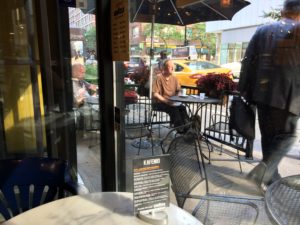The Lived-In City
At dinner last night at Shaw’s Crab House in Chicago, my wife and I were trying to find the word to describe why we liked the place so well. Miller’s Pub in Chicago and Murray’s Steakhouse in our own Minneapolis are similar in this regard. Shaw’s is old without being aged, clean without being immaculate and happily humming without being overcrowded. We settled on the term “lived-in.” Shaw’s was a wonderful experience because it felt “lived-in.” Do they feel “lived-in?” This is a very tangible yet subjective measure, and is often missed when discussing development and cities.
And so, my view this morning from a seat by the window of a coffeeshop in the Streeterville neighborhood in Chicago is a good test. The urbanism is pretty good, with a few blemishes. There are streets and buildings, sidewalks and frontage, both retail and residential, with windows and doors. There is some greenery from boulevard trees and planters, and a few restaurants have sidewalk seating. I can excuse blackened gum stuck on the sidewalk, slightly uneven pavement, and a few buildings that have blank walls.
Out this window hundreds of people pass by per hour. People are coming and going on this weekday morning, in and out of the cafe where I sit, the hotel next door, walking past on the way to work or workouts. They are hailing cabs, standing on the sidewalk taking to a colleague, or reading a book. All ages are represented, from stroller to cane. A cabdriver leans on his car, smoking a cigarette and talking on his phone, waiting for a fare (no doubt as several Ubers drive past), and a construction worker walks in to the 7-Eleven for a snack. A restaurant owner is hosing down the sidewalk in front of her storefront. The view out the window is undeniably busy. This neighborhood is certainly “lived-in.”
Streeterville is a mishmash of old and new, low- and high-rise, making it aesthetically less pleasing than other Chicago neighborhoods like Lincoln Square or Rogers Park. And there is a lot of traffic. Warts and all, it is very dense and very walkable, populated by residents but also Michigan Avenue shoppers and employees from nearby Northwestern Memorial Hospital. So the urban design isn’t perfect, but there are also fatal flaws, so therefore it is the people that makes it a “lived-in” neighborhood.
That a healthy percentage of these people are good looking no doubt elevates people watching immensely, reminding me it’s good to be alive. Nonetheless, it is people that make a city possible. This test can apply to all sorts of situations, from the new Commons park in downtown Minneapolis to infill development there and elsewhere in the city. It’s why, in my most recent post, that I prefer the Seward Co-op with a single door facing the parking lot AND sidewalk, to be shared by all people, concentrating activity in a single place. So while it is important to debate issues like building materials, runoff and exact placement of plantings, these things alone don’t make a city likable and “lived-in.” Density, decent sidewalks and good frontage are essential to achieving this, and frankly being too prescriptive can suffocate the potential for cities to create identities of their own. The real measure of a successful city is if it’s “lived-in.”
No Comments »
No comments yet.
RSS feed for comments on this post. TrackBack URI
Leave a comment
Line and paragraph breaks automatic, e-mail address never displayed, HTML allowed: <a href="" title=""> <abbr title=""> <acronym title=""> <b> <blockquote cite=""> <cite> <code> <del datetime=""> <em> <i> <q cite=""> <s> <strike> <strong>

